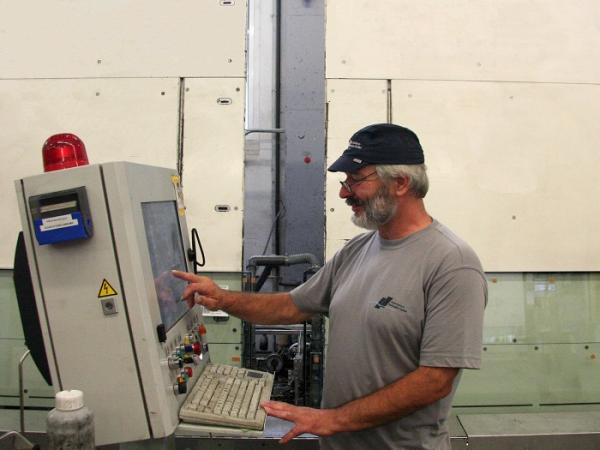With state-of-the-art systems the volume flow of the sealant material was not sufficient enough for large sealing depths or widths and due to high system pressure there was no chance to enlarge the volume flow considerably with the static mixing system. With the increasing share of triple glazing, the sealing robot got more and more a bottleneck in the production.
The rapid growing share of triple glazed IG units in the production mix of insulating glass manufacturers resulted in a lot of requests for speeding up insulating glass lines. The customers wished to have the same production speed for triple insulating glass as they have had before for double insulating glass. This should be possible without enlarging the production line and without loosing flexibility.
Therefore it was necessary to find a solution for providing a higher material volume for the sealing robot, which is seen as the biggest bottleneck in the production. The result was a complete new dosing and dynamic mixing system for the sealing robot, which was able to overcome the limitations of a static mixer.
The static mixing system
The state-of-the-art mixing system so far for sealing robots was the static mixer. The number of cross bars in the mixer determines the mixing quality and the pressure drop of the system. The increase of the volume flow is limited by these restrictions. For the speed’sealer is was necessary to introduce new dynamic mixing elements which are offering a higher volume flow and reducing the material pressure at the same time.
Figure 1: Mixing maps in static mixers with different cross-bar number
Figure 2: Pressure drop ratios for different cross-bar number
The dynamic mixing system
The dynamic mixer has a motor-driven mixing element, which rotates at a regulated speed in a mixing chamber. The active mixing is a bidirectional process: parallel and cross the material flow direction. The mixing element itself is not hollow and looks like a driller. The dosing is done by two gear pumps and with the pressure and temperature sensors we learned how the system had to be adjusted for optimum results.
Figure 3: New dynamic mixing and dosing system
Click to enlarge
UserFiles/Bystronic glass Sealing_Fig03big.jpg
The new dynamic mixing system shows an increased volume flow up to factor 4 compared to a static mixing system. At the same time the comparable system pressure is only a quarter of the one of the static mixer.
Figure 4: Material pressure of 2K-Silicone
Click to enlarge
UserFiles/Bystronic glass Sealing_Fig04big.jpg
An experimental examination of the “Institut für Kunststofftechnik” in Stuttgart comparing different shearing and mixing elements for single-screw extruders shows that the mixing quality is more homogeneous when using the dynamic mixer instead of a static mixer.
Figure 5: The visible result of the mixer comparison of “Institut für Kunststofftechnik” in Stuttgart
The Bystronic glass speed’sealer is establishing a new benchmark in sealing quality and sealing speed due to its dynamic mixing system which is unique for sealing robots in the insulating glass industry. Therefore it suits very well to the increasing number of triple glazed IG units as well as façade elements, where a high material volume is needed. The output increase is up to 130% compared to a static mixing sealant robot:
Figure 6: Output increase with the dynamic speed’sealer
Click to enlarge
UserFiles/Bystronic glass Sealing_Fig06(1).jpg
The speed’sealer combines unique characteristics with the dynamic mixing system:
- Best mixing homogeneity (according to independent analysis)
- Maximum volume flow of 6 litres/minute, independent of sealant material
- Highest application speed of 60 meter/minute
- Minimized material pressure of the sealant components
References
[1] S. Liu, A.N. Hrymak and P.E. Wood, “Laminar mixing in SMX Static Mixer”, Department of Chemical Engineering, McMaster University, 2005
[2] E. Grünschloß und L. Gunning, “Comparative experimental examinations of different shearing and mixing elements for single-screw extruders” IKT, 2009
Website:
www.bystronic-glass.com/speedsealer
About Bystronic glass
Bystronic glass is the most competent and reliable partner for services, machinery, plants and systems in the glass processing sector. Bystronic glass supplies its well-proven machine technologies also in important areas of the photovoltaic industry. This includes preprocessing, front-end and back-end solutions. Bystronic glass is an international brand with globally operating companies that support their customers on site and through own sales and service companies. Since 1994, Bystronic glass is part of the Conzzeta AG, a renowned Swiss industrial holding company.
Klaus Puschmann - Bystronic Lenhardt GmbH
Bystronic glass media contact:
Iris Minten
PR / Online Communication
c/o Bystronic Lenhardt GmbH
Karl-Lenhardt-Str. 1-9
D-75242 Neuhausen-Hamberg
Phone +49 (0)7234 601 120
Fax +49 (0)7234 601 114
iris.minten@bystronic-glass.com
www.bystronic-glass.com
Bystronic glass sales contact:
E-Mail: sales@bystronic-glass.com
For the contact details of Bystronic glass global representatives please visit www.bystronic-glass.com


















